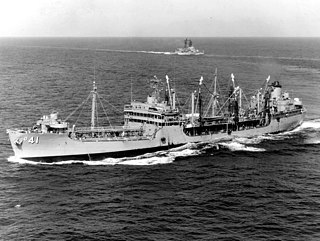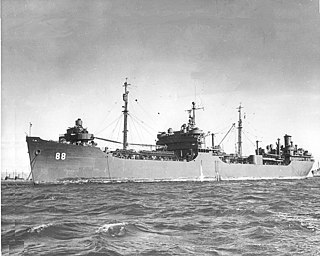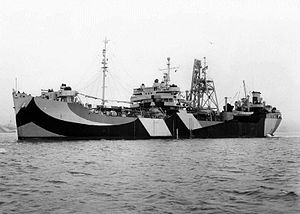
USS Abatan (AW-4) was a Pasig-class distilling ship built for the United States Navy during World War II, named after the Abatan River located in the southwestern part of Bohol Island in the Philippines.

USS Ponaganset AO-86/AOG-86) was a Suamico-class fleet oiler, of the T2-SE-A2 tanker hull type, serving in the United States Navy during World War II. Laid down on 27 April 1942, she was named for the Ponaganset River located in Foster and Glocester, Rhode Island.
USS Armadillo (IX-111), the lead ship of her class of tanker was the only ship of the United States Navy to be named for the armadillo, an insect-eating mammal which has an armorlike shell encasing its back and head.

USS Wildcat (AW-2), was a Stag-class distilling ship, built for the United States Navy during World War II, the only U.S. Naval vessel to be named for Felis silvestris.

USS Stag (AW-1) was one of four water distilling ships built for the United States Navy during World War II. The lead ship of two in her class, she was named for a ruminant mammal belonging to the family Cervidae.

USS Neosho (AO–48) was a Kennebec-class type T2 fleet oiler of the United States Navy. The ship was laid down on 8 July 1941, as SS Catawba, by the Bethlehem-Sparrows Point Shipyard Inc., Sparrows Point, Maryland. The purchase came under Maritime Commission contract number 145 for the Socony-Vacuum Oil Company, later renamed Mobil Oil.

USS Mattaponi (AO-41) was a Kennebec-class oiler which served in the United States Navy during World War II, periodically during the 1950s, and in the Vietnam War. She was the only U.S. Navy ship named for the Mattaponi River in eastern Virginia.

USS Schuylkill (AO-76), originally named the SS Louisburg, was a Type T2-SE-A1 Suamico-class fleet oiler of the United States Navy.

USS Chicopee (AO-34) was the lead ship of her class of oilers for the United States Navy during World War II. She was the second U.S. Navy ship named for the Chicopee River located in Massachusetts.

USS Soubarissen (AO-93) was an Escambia-class fleet oiler converted to a water tanker, named for a chief of the "Neutral" Indian Nations which, although a part of the Iroquois confederation, were called "neutral" by the French because they took no part in the wars of the Iroquois and Hurons. The area he governed included the oil fields of northwestern Pennsylvania and western New York. The knowledge of the oil seepages there was well known among the Indians, and it was declared neutral ground so all Indians could obtain oil for medicinal and domestic purposes without danger or interference. In 1627, Joseph de La Roche Daillon heard of the oil springs and made an expedition to visit them. He was kindly received by Chief Soubarissen, shown the oil seepages, and duly reported his observations to his superiors. These observations contributed largely to the interest in the petroleum resources of the Pennsylvania region.

USS Mascoma (AO-83) was a Escambia-class replenishment oiler constructed for the United States Navy during World War II. She served her country in the Pacific Ocean Theatre of Operations, and provided petroleum products where needed to combat ships. For her very dangerous work under combat conditions, she was awarded seven battle stars by war's end.

USS Marias (AO-57) was a Cimarron-class fleet oiler acquired by the U.S. Navy during World War II. She served her country primarily in the Pacific Ocean Theatre of Operations, and provided petroleum products where needed to combat ships. For performing this dangerous task, she was awarded eight battle stars during World War II, and one campaign star during the Vietnam War for her bravery in combat areas.

USS Tomahawk (AO-88) was an Escambia-class fleet oiler acquired by the United States Navy for use during World War II. She had the dangerous but necessary task of providing fuel to vessels in combat and non-combat areas primarily in the Pacific Ocean. For her valiant efforts, she received six battle stars during the war.
USS Oklawaha (AO-84) was a Escambia-class replenishment oiler acquired by the United States Navy for use during World War II. She had the dangerous but necessary task of providing water to smaller vessels not fitted with water-makers in combat and non-combat areas.
USS Anacostia (AO-94) was a Escambia-class replenishment oiler acquired by the United States Navy for use during World War II. She had the dangerous but necessary task of providing fuel to vessels in combat and non-combat areas. She served in the Pacific Ocean Theater of operations late in the war, and returned home with one battle star.
USS Tamalpais (AO-96) was a Escambia-class replenishment oiler acquired by the United States Navy for use during World War II. She had the dangerous but necessary task of providing fuel to vessels in combat and non-combat areas. She served in the Pacific Ocean Theatre of operations late in the war.

USS Cohocton (AO-101) was lead ship of her class of fleet oiler acquired by the United States Navy for use during World War II. She had the dangerous but necessary task of providing fuel to vessels in combat and non-combat areas. She served in the Pacific Ocean Theatre of operations late in the war.

USS Severn (AO-61) was a Cimarron-class fleet oiler. She was constructed for the U.S. Navy during World War II and her assignment was to provide liquids, such as fuel or water, to ships in the forward battle areas. She survived this dangerous task and returned home post-war with two battle stars to her credit.

USS Tombigbee (AOG-11) was a Patapsco-class gasoline tanker in service with the United States Navy from 1943 to 1972. She was then sold to Greece, where she served as Ariadni (A414) until 2003.

The Suamico class were a class of 25 United States Navy oilers during World War II. Built to the Maritime Commission T2-SE-A1, -A2 and -A3 (Cohocton) designs, they used turbo-electric transmission, obviating the need for reduction gearing which was a major issue in US mass-production shipbuilding.















